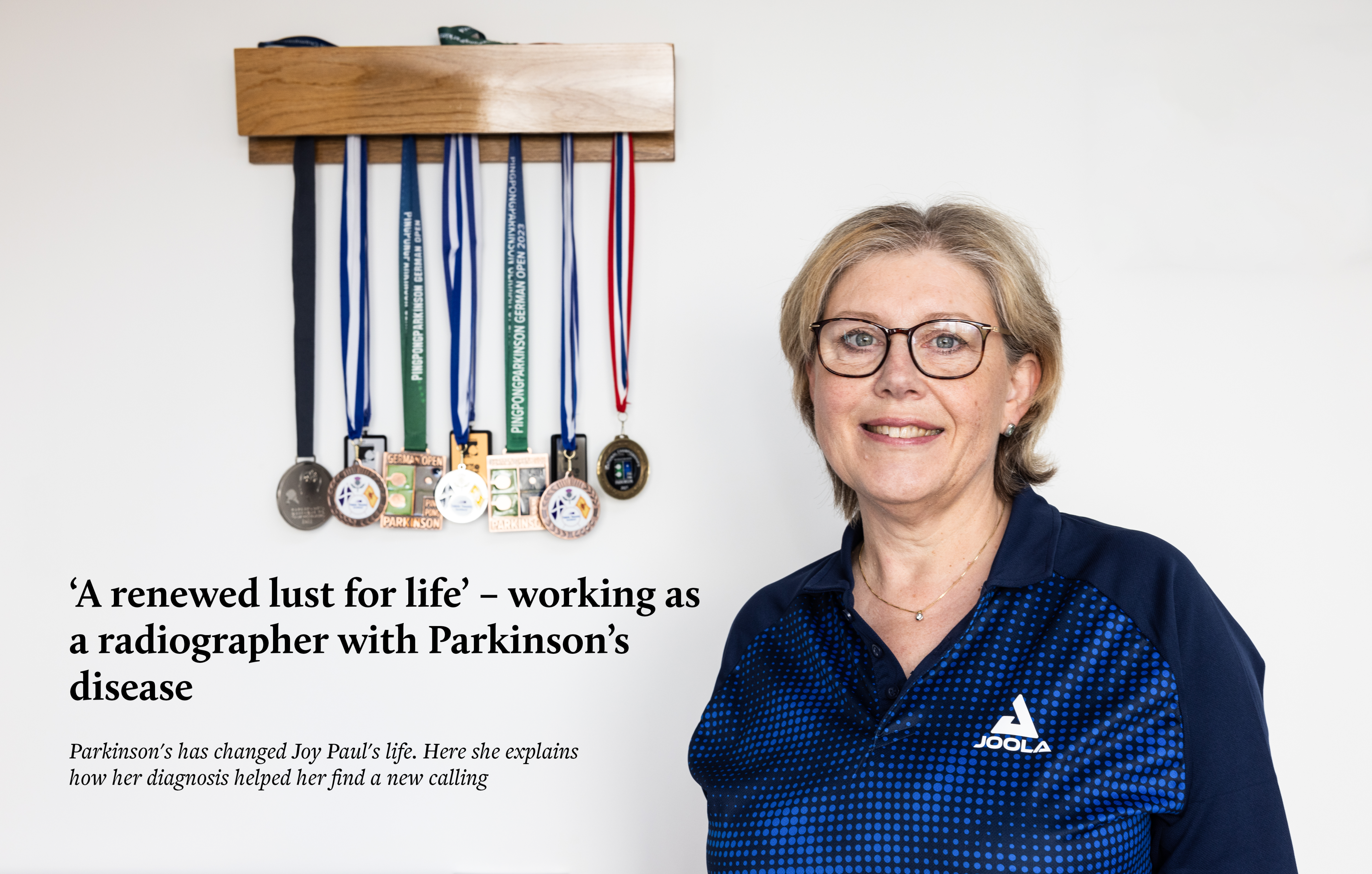
‘A renewed lust for life’ – working as a radiographer with Parkinson’s disease
Parkinson's has changed Joy Paul's life. Here she explains how her diagnosis helped her find a new calling
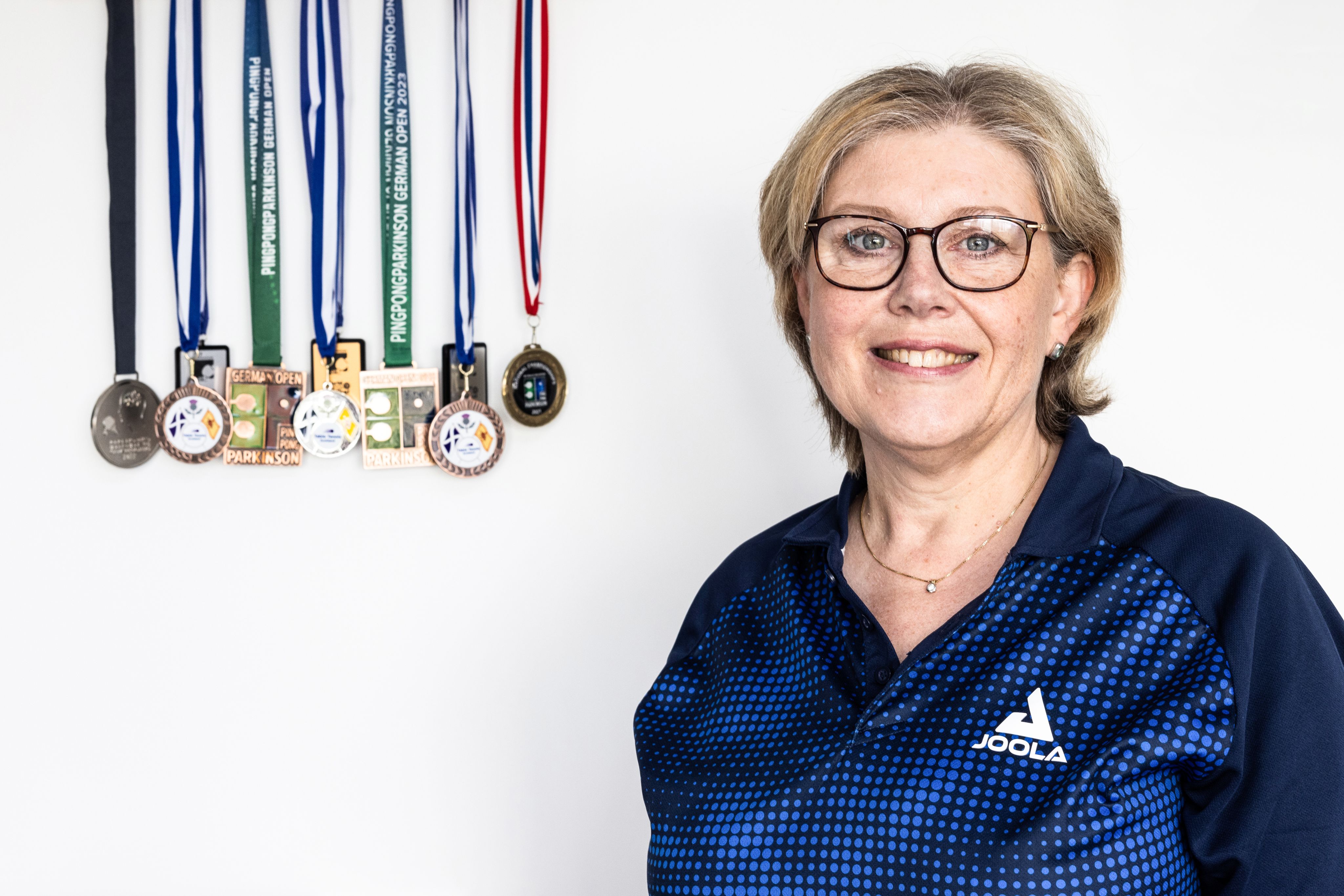
Joy Paul is a senior radiographer, and was diagnosed with Parkinson’s disease 15 years ago, when she was just 40 years old.
Parkinson’s is a progressive disorder caused by a lack of dopamine, which is necessary for smooth muscle movement. It affects the nervous system and the parts of the body controlled by the nerves, causing tremors, stiffness, and slowing of movement.
But Joy doesn’t let her symptoms stop her, as she still works full time in the radiology department at University Hospital Ayr, and has also recently been competing at a very high level in table tennis tournaments specifically for people living with Parkinson’s.
Joy explained to Synergy, that although drugs she takes for the disease do help it can be hard to deal with her Parkinson’s when they wear off. The drugs also have side effects – including dyskinesia, which causes involuntary writhing movements, and gets worse during stressful moments.
“It’s all part and parcel with the drugs. I fare pretty well most of the time,” she said. “But then the drugs wear off, and it's a bit harder to cope. It’s quite hard to deal with, or function, pretty well most of the time.”
Joy Paul is a senior radiographer, and was diagnosed with Parkinson’s disease 15 years ago, when she was just 40 years old.
Parkinson’s is a progressive disorder caused by a lack of dopamine, which is necessary for smooth muscle movement. It affects the nervous system and the parts of the body controlled by the nerves, causing tremors, stiffness, and slowing of movement.
But Joy doesn’t let her symptoms stop her, as she still works full time in the radiology department at University Hospital Ayr, and has also recently been competing at a very high level in table tennis tournaments specifically for people living with Parkinson’s.
Joy explained to Synergy, that although drugs she takes for the disease do help, it can be hard to deal with her Parkinson’s when they wear off. The drugs also have side effects – including dyskinesia, which causes involuntary writhing movements, and gets worse during stressful moments.
“It’s all part and parcel with the drugs. I fare pretty well most of the time,” she said. “But then the drugs wear off, and it's a bit harder to cope. It’s quite hard to deal with, or function, pretty well most of the time.”

“I’ve just tried to carry on as best I can, as normally as I can,” she added. “I’ve got some coping mechanisms, which help, and I usually do better in the mornings, but then the drugs work off. I can work through it. It’s an effort and a struggle at times, it just takes me a bit longer to do things. I manage pretty well though.”
The practical side of radiography is Joy’s strong suit – the majority of the time she’s working in CT and MRI, and even when she is suffering from more severe symptoms, she can manage them while working with patients.
Other areas, such as admin duties, present more of a problem as tremors make typing very difficult: “I can usually swap with someone [if symptoms are too severe]. Luckily, I haven’t had to [swap] very much.
“I’ve just tried to carry on as best I can, as normally as I can,” she added. “I’ve got some coping mechanisms, which help, and I usually do better in the mornings, but then the drugs work off. I can work through it. It’s an effort and a struggle at times, it just takes me a bit longer to do things. I manage pretty well though.”
The practical side of radiography is Joy’s strong suit – the majority of the time she’s working in CT and MRI, and even when she is suffering from more severe symptoms, she can manage them while working with patients.
Other areas, such as admin duties, present more of a problem as tremors make typing very difficult: “I can usually swap with someone [if symptoms are too severe]. Luckily, I haven’t had to [swap] very much.
‘It really got us through’
Joy’s experience with table tennis dates back to 2020, as the severity of the coronavirus pandemic became clear. Concerned about the risk the virus posed to people with Parkinson’s, Joy started to research the potential impacts on her health if she caught Covid.
“It all started when Covid was first emerging,” Joy explained. “I started trying to find out if I was more at risk because of my diagnosis, whether I was more in danger than the general public. I stumbled across this article talking about Parkinson’s and table tennis, which said it was supposed to be good for the brain.
“I used to be quite sporty – I played hockey in school and then for a club, before playing competitive league squash. I hadn’t been exercising much recently, so I thought I’d have a go at it. My husband got us a table in the house, so we could play without worrying about Covid. That really got us through, the exercise and the fun.”
Joy knew she needed to practice against other people and get more experience before she could participate in any competitions, so she reached out to a coach at a local table tennis club.
While the club was unable to have group sessions because of pandemic restrictions, Joy was able to organise one-to-one lessons.
Once restrictions were lifted to allow three-person sessions, Joy was able to regularly play and have two-hour lessons a week.
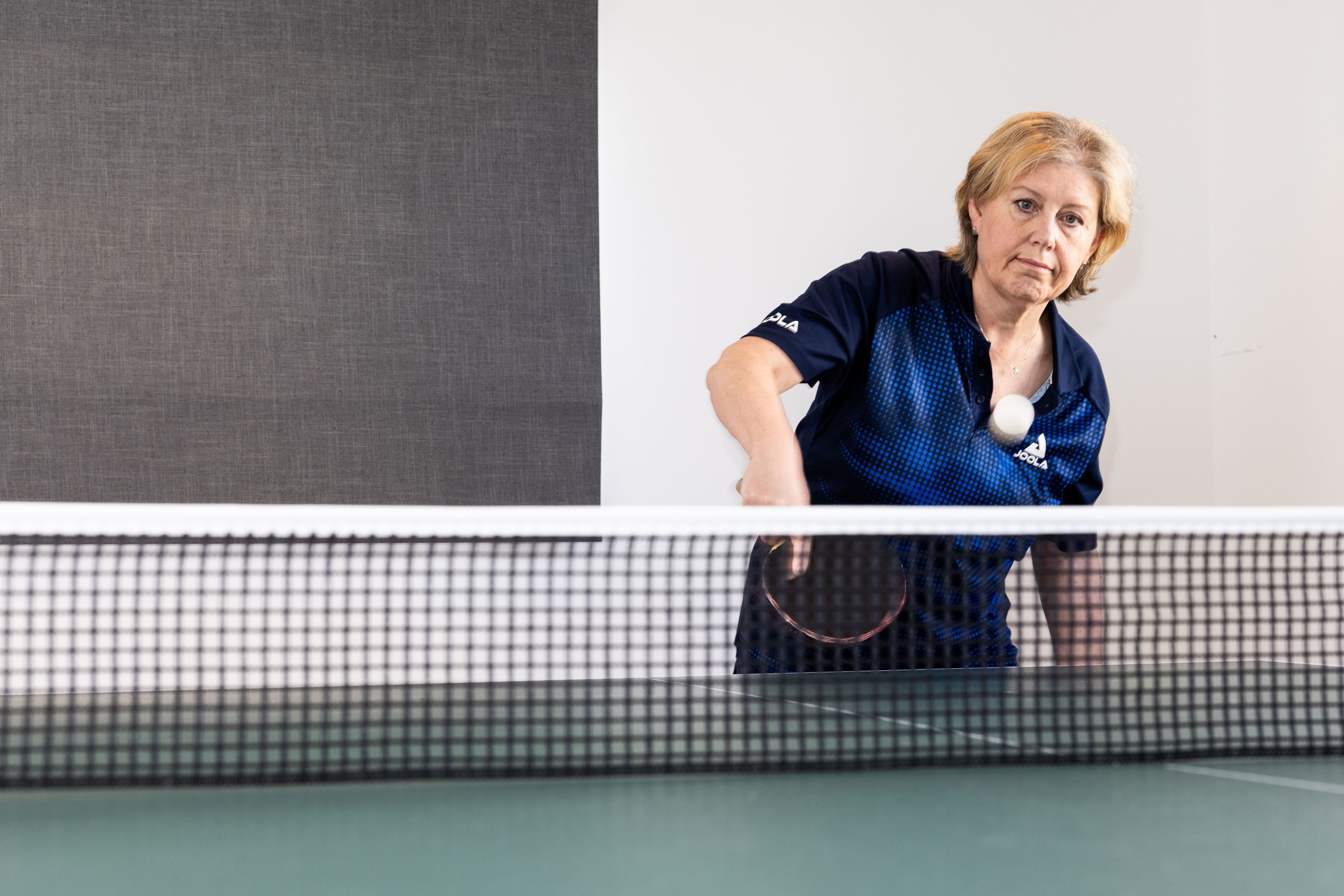

‘It really got us through’
Joy’s experience with table tennis dates back to 2020, as the severity of the coronavirus pandemic became clear. Concerned about the risk the virus posed to people with Parkinson’s, Joy started to research the potential impacts on her health if she caught Covid.
“It all started when Covid was first emerging,” Joy explained. “I started trying to find out if I was more at risk because of my diagnosis, whether I was more in danger than the general public. I stumbled across this article talking about Parkinson’s and table tennis, which said it was supposed to be good for the brain.
“I used to be quite sporty – I played hockey in school and then for a club, before playing competitive league squash. and I hadn’t been exercising much recently, so I thought I’d have a go at it. My husband got us a table in the house, so we could play without worrying about Covid. That really got us through, the exercise and the fun.”
Joy knew she needed to practice against other people and get more experience before she could participate in any competitions, so she reached out to a coach at a local table tennis club.
While the club was unable to have group sessions because of pandemic restrictions, Joy was able to organise one-to-one lessons.
Once restrictions were lifted to allow three-person sessions, Joy was able to regularly play and have two-hour lessons a week.

The championships
Joy’s first Parkinson’s table tennis competition was the 2021 British championships, which took place in St. Neots, near Cambridge, and where she took home her first medal – a bronze in the women’s singles.
Later that year Joy set off for Berlin for the ITTF Parkinson’s World Table Tennis Championships, where she managed to make it through to the quarter finals for both the singles and the mixed doubles events.
It was the second ever such event, and aimed to raise awareness of the positive health benefits of playing table tennis for people with Parkinson’s, and to provide networking opportunities for the people diagnosed with it and their families to exchange ideas and experiences.
It was delayed twice during the pandemic before finally being set for October of 2021.
On her experience in Berlin, she said: “So that was quite good – and then I just kind of built up from there. There’s a massive number of people in Germany with Parkinson’s, with over 1,000 registered players. Each year since 2021 they have hosted the German Open - an international tournament almost as big as the world champs. In 2022 , just with all that practice, I managed to beat the defending champion in the quarter final and went on to win a bronze medal.”
Joy added that at first, she hadn’t even realised she was playing the previous year’s gold medallist in the quarter finals. Match listings were announced over microphone, and Joy had missed the details of who, exactly, she was playing.
She continued: “I thought I was playing someone else, to be honest. I hadn’t had time to think ‘Oh my god, I’m playing the champion’. She beat me in the first set, actually, but I thought to myself – if I do this shot here, and that shot there… I think I could beat her.
“It’s all about self belief, I think. I won the next game, and I could see she was starting to get a little bit flustered, and that gave me more confidence. Then I won the next game, by which point she had her coach, and her doubles partner talking to her, giving her advice.
The championships
Joy’s first Parkinson’s table tennis competition was the 2021 British championships, which took place in St. Neots, near Cambridge, and where she took home her first medal – a bronze in the women’s singles.
Later that year Joy set off for Berlin for the ITTF Parkinson’s World Table Tennis Championships, where she managed to make it through to the quarter finals for both the singles and the mixed doubles events.
It was the second ever such event, and aimed to raise awareness of the positive health benefits of playing table tennis for people with Parkinson’s, and to provide networking opportunities for the persons diagnosed with it and their families to exchange ideas and experiences.
It was delayed twice during the pandemic before finally being set for October of 2021.
On her experience in Berlin, She said: “So that was quite good – and then I just kind of built up from there. There’s a massive number of people in Germany with Parkinson’s, with over a thousand registered players. Each year since 2021 they have hosted the German Open - an international tournament almost as big as the world champs. In 2022 , just with all that practice, I managed to beat the defending champion in the quarter final and went on to win a bronze medal.”
Joy added that at first, she hadn’t even realised she was playing the previous year’s gold medallist in the quarter finals. Match listings were announced over microphone, and Joy had missed the details of who, exactly, she was playing.
She continued: “I thought I was playing someone else, to be honest. I hadn’t had time to think ‘Oh my god, I’m playing the champion’. She beat me in the first set, actually, but I thought to myself – if I do this shot here, and that shot there… I think I could beat her.
“It’s all about self belief, I think. I won the next game, and I could see she was starting to get a little bit flustered, and that gave me more confidence. Then I won the next game, by which point she had her coach, and her doubles partner talking to her, giving her advice.
“I thought, ‘I’ve got her rattled’. I knew if I beat her I’d win a bronze medal, and that spurred me on. I played her doubles partner in the semi-final and she beat me three sets to two, but I was delighted to take home the bronze.”
She told Synergy she’d never had that much practice with the sport, other than occasionally putting a net on the dining room table as a child.
In November 2023, Joy returned to the world championships, this time held in Crete, Greece, where she took home the silver medal in both the women's doubles and the mixed doubles during the tournament last November. She also won a bronze medal in the singles competition.
She said: “Table tennis has given me a renewed lust for life and a hobby which I love.”
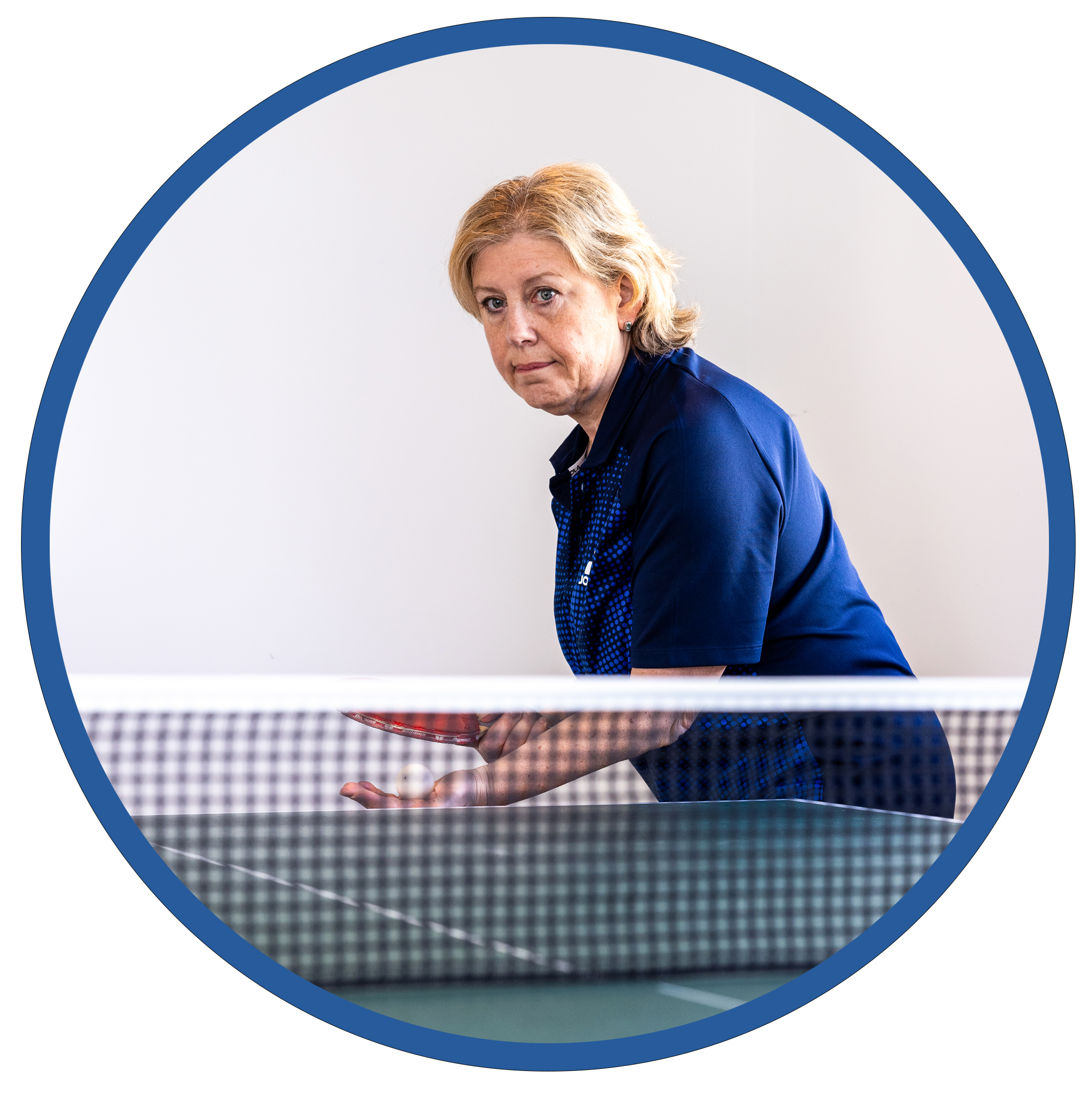

“I thought, ‘I’ve got her rattled’. I knew if I beat her I’d win a bronze medal, and that spurred me on. I played her doubles partner in the semi-final and she beat me three sets to two, but I was delighted to take home the bronze.
Taking part in the world championships, however, has been the highlight of Joy’s experience with the disorder, she said.
She told Synergy she’d never had that much practice with the sport, other than occasionally putting a net on the dining room table as a child.
In November 2023, Joy returned to the world championships, this time held in Crete, Greece, where she took home the silver medal in both the women's doubles and the mixed doubles during the tournament last November. She also won a bronze medal in the singles competition.
She said: “Table tennis has given me a renewed lust for life and a hobby which I love.”
The joy of table tennis
Initially, Joy was averse to telling people about her condition.
She explained to Synergy she felt embarrassed by her diagnosis, and she was left to simply carry on and to try to hide it for several years.
It wasn’t until Joy started playing table tennis that she felt able to reveal her condition to her coworkers.
“I sort of dropped in that it was Parkinson’s table tennis, so the focus was more on the table tennis,” Joy said. “I haven’t asked for much at the hospital. I stopped doing on-calls just in the last year, and I’ve been exempted from doing the night shifts. That’s been really good.”
‘It made me think about things differently’
Joy explained that a more senior member of staff at her trust, upon realising she was no longer doing on-call duties, planned to send her to a satellite hospital.
“That wasn’t easy to take,” she added. “To think you’re just a number, that you’re not really valued. I’ve been there for 20-odd years.”
Luckily, Joy’s line manager stepped in to help. She argued that the hospital could utilise Joy’s skills in MRI, and that she believed Joy had a lot to offer the department.
“I think my supervisor had a bit of a knee-jerk reaction to hearing I wasn’t doing on-call any more, but it still made me think about things differently,” Joy said. “Apart from that incident, they’ve been very accommodating, very understanding.”
The joy of table tennis
Initially, Joy was averse to telling people about her condition.
She explained to Synergy she felt embarrassed by her diagnosis, and she was left to simply carry on and to try to hide it for several years.
It wasn’t until Joy started playing table tennis that she felt able to reveal her condition to her coworkers.
“I sort of dropped in that it was Parkinson’s table tennis, so the focus was more on the table tennis,” Joy said. “I haven’t asked for much at the hospital. I stopped doing on-calls just in the last year, and I’ve been exempted from doing the night shifts. That’s been really good.”
‘It made me think about things differently’
Joy explained that a more senior member of staff at her trust, upon realising she was no longer doing on-call duties, threatened to send her off to a “satellite hospital.”
“That wasn’t easy to take,” she added. “To think you’re just a number, that you’re not really valued. I’ve been there for 20-odd years.”
Luckily, Joy’s line manager stepped in to help. She argued that the hospital could utilise Joy’s skills in MRI, and that she believed Joy had a lot to offer the department.
“I think my supervisor had a bit of a knee-jerk reaction to hearing I wasn’t doing on-call any more, but it still made me think about things differently,” Joy said. “Apart from that incident, they’ve been very accommodating, very understanding.”

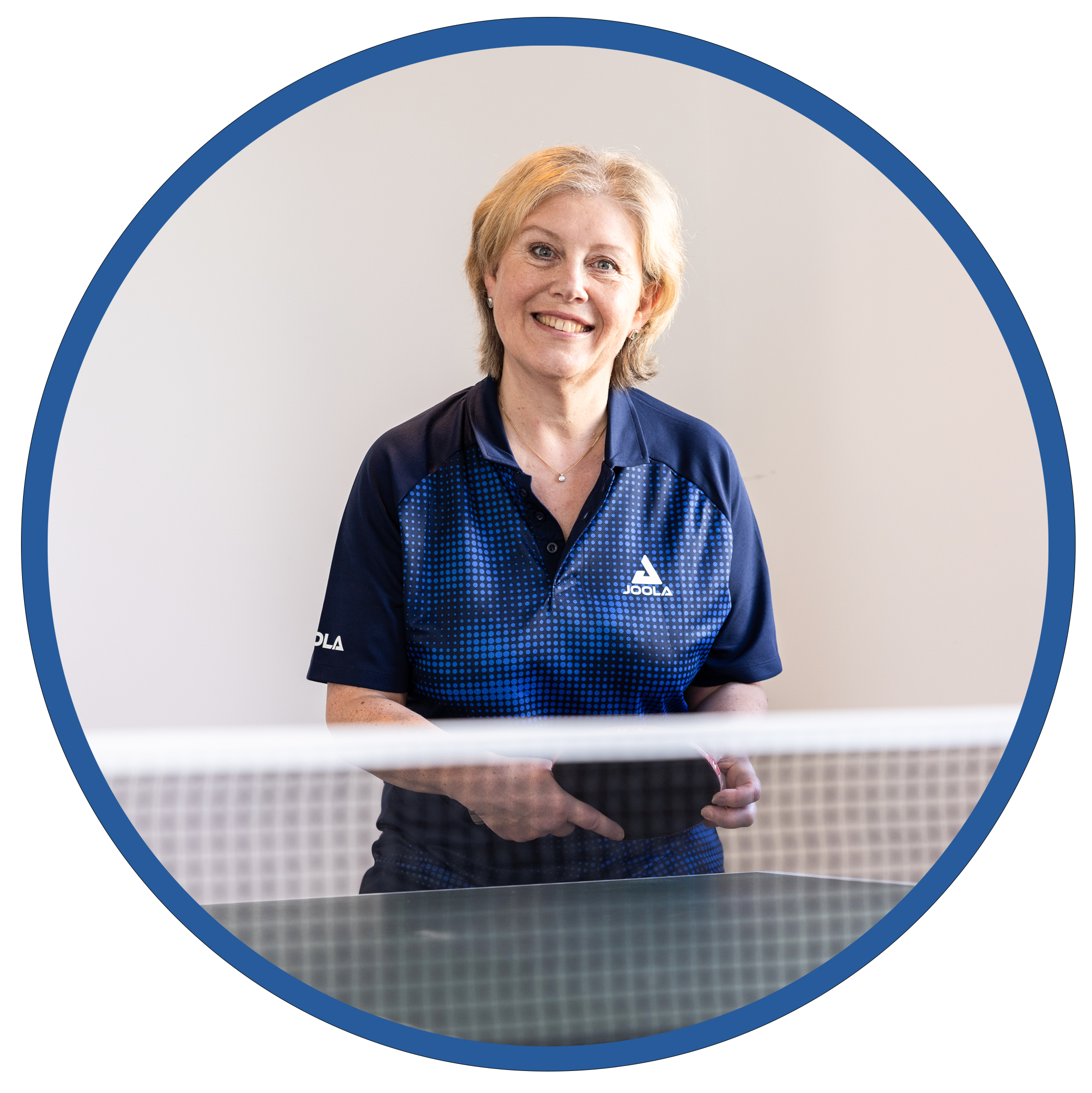
‘It hasn’t all been plain sailing’
Joy also spoke to Synergy about what had first attracted her to the profession of radiography, and her experiences going from student to working full time.
She said: “It hasn’t all been plain sailing. I don’t think I ever had an overwhelming desire to be a radiographer. I was leaving school, and I applied for multiple different things. I quite liked the idea of working in a hospital, and I was intrigued by all the different jobs there were.”
While she didn’t think she quite had the “stomach” to be a nurse, Joy found herself fascinated by the images produced during diagnostic radiography.
Joy chose to join the radiography course. She qualified after three years and took her first role at Falkirk Royal Infirmary, where she worked from 1990 to 1992.
Despite really enjoying the work, she wanted to move back to where she trained in Glasgow, where she worked in general radiography at Stobhill Hospital for two years from 1992 to 1994 – however she grew “bored” with general radiography and wanted to get involved in more in-depth imaging techniques.

‘It hasn’t all been plain sailing’
Joy also spoke to Synergy about what had first attracted her to the profession of radiography, and her experiences going from student to working full time.
She said: “It hasn’t all been plain sailing. I don’t think I ever had an overwhelming desire to be a radiographer. I was leaving school, and I applied for multiple different things. I quite liked the idea of working in a hospital, and I was intrigued by all the different jobs there were.”
While she didn’t think she quite had the “stomach” to be a nurse, Joy found herself fascinated by the images produced during diagnostic radiography.
Joy chose to join the radiography course. She qualified after three years and took her first role at Falkirk Royal Infirmary, where she worked from 1990 to 1992.
Despite really enjoying the work, she wanted to move back to where she trained in Glasgow, where she worked in general radiography at Stobhill Hospital for two years from 1992 to 1994 – however she grew “bored” with general radiography and wanted to get involved in more in-depth imaging techniques.
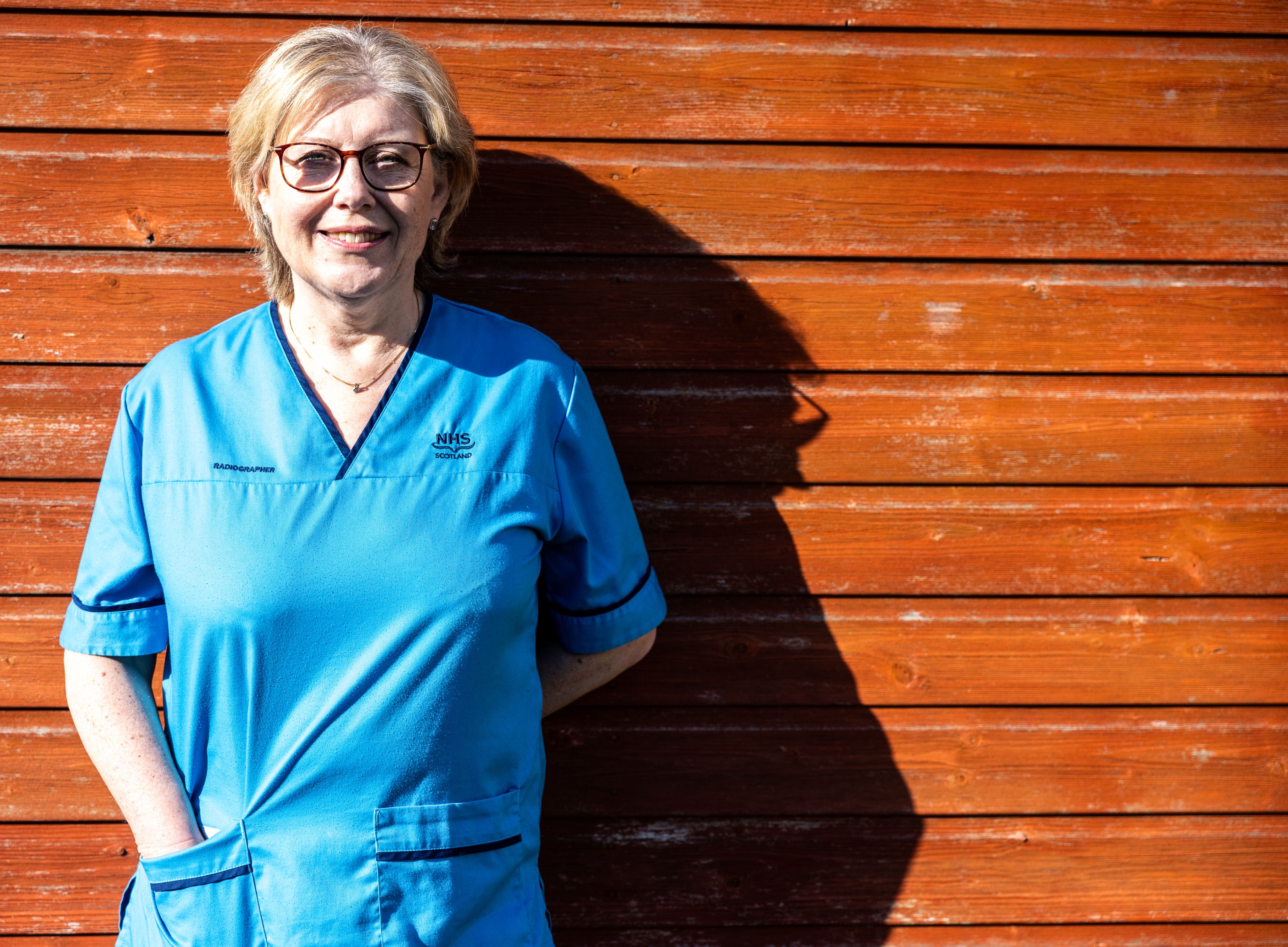
Joy was unfortunately forced to give up her responsibilities with interventional radiography, however, as the role became “too stressful” – however, this has allowed her to focus on CT and MRI for the last two decades.
“I think I prefer MRI more, but it’s getting a bit complicated,” she added. “They’ve gotten a new scanner, which has taken some getting used to. I got a postgraduate certificate in MRI about five years ago, which has really helped.”
Joy’s postgraduate paper, ‘Peer review MRI: a quality improvement programme and pilot study’, was published in the SoR journal Radiography in 2021.
“My first piece of advice is to keep working,” Joy said, when asked what advice she would give to fellow workers with Parkinson’s. “I know some people who gave up working, and it spiralled down, health-wise and money-wise. Work as long as you can.
“Your occupational health department can put things in place if you need any additional support. There are people that will fight in your corner if you’re having problems with management. Keep your life as normal as you can for as long as you can.”
Joy also warned against hiding your condition, which is what she had done initially.
“Because I was embarrassed about my condition, I didn’t seek out any help at work. I didn’t realise, there’s a lot of young people who get Parkinson’s. I thought it was an old person’s disease. I didn’t want to go to any support groups, because I thought they’d be full of old people and it would fill me with fear.
“I thought, I don’t want to see how bad I’ll get. But I think playing table tennis really helped. Find something that will inspire you to keep fighting.”
Joy was unfortunately forced to give up her responsibilities with interventional radiography, however, as the role became “too stressful” – however, this has allowed her to focus on CT and MRI for the last two decades.
“I think I prefer MRI more, but it’s getting a bit complicated,” she added. “They’ve gotten a new scanner, which has taken some getting used to. I got a postgraduate certificate in MRI about five years ago, which has really helped.”
Joy’s postgraduate paper, ‘Peer review MRI: a quality improvement programme and pilot study’, was published in the SoR journal Radiography in 2021.
“My first piece of advice is to keep working,” Joy said, when asked what advice she would give to fellow workers with Parkinson’s. “I know some people who gave up working, and it spiralled down, health-wise and money-wise. Work as long as you can.
“Your occupational health department can put things in place if you need any additional support. There are people that will fight in your corner if you’re having problems with management. Keep your life as normal as you can for as long as you can.”
Joy also warned against hiding your condition, which is what she had done initially.
“Because I was embarrassed about my condition, I didn’t seek out any help at work. I didn’t realise, there’s a lot of young people who get Parkinson’s. I thought it was an old person’s disease. I didn’t want to go to any support groups, because I thought they’d be full of old people and it would fill me with fear.
“I thought, I don’t want to see how bad I’ll get. But I think playing table tennis really helped. Find something that will inspire you to keep fighting.”

Images: John Need
About the World Parkinson's Table Tennis Championships
The World Parkinson's Table Tennis Championships is organised by the International Table Tennis Federation and is now in its fourth year.
It aims to be a global celebration of people living with Parkinson's and to raise awareness of the positive benefits of playing table tennis.
Read more


